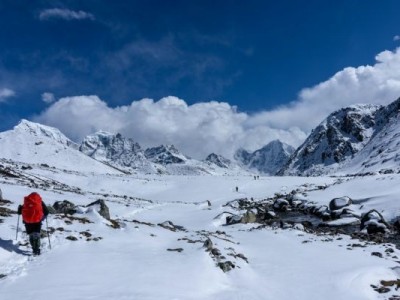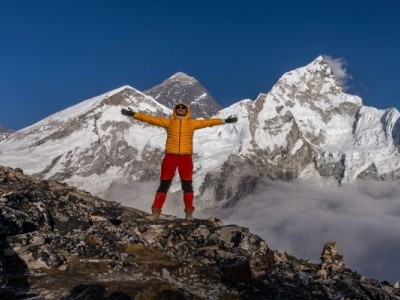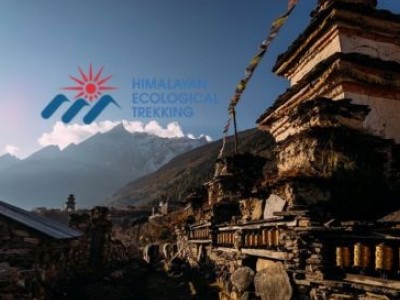Manaslu Circuit Trek Difficulty Level: A Comprehensive Assessment
Difficulty Rating

The Manaslu Circuit Trek is one of the most challenging treks in Nepal. It is rated as difficult to very difficult on the standard trekking difficulty scale of easy, moderate, difficult, and very difficult. As the trek has many difficult components, the Manaslu trek in Nepal will be more difficult than the other options, like Annapurna Base Camp or Poon Hill.
The Manaslu trek has several difficulty components:
- Daily walking times of 6-8 hours on a mixture of terrain
- Crossing Larkya La Pass with a summit elevation of 5,106 meters.
- Maximum sleeping altitude of 4,480 meters at Dharamsala
- Steep climbs, technical rocky sections, and potential glacier crossings
- Remote trekking locations with limited access for rescue and basic facilities
Here's how Manaslu Circuit compares to other major Nepal treks:
Trek Name | Maximum Altitude | Difficulty Level | Duration |
Manaslu Circuit | 5,106m | Very Difficult | 14-18 days |
Everest Base Camp | 5,364m | Difficult | 12-14 days |
Annapurna Circuit | 5,416m | Moderate-Difficult | 14-21 days |
Langtang Valley | 3,870m | Moderate | 7-10 days |
Three Passes | 5,545m | Very Difficult | 18-21 days |
Altitude Considerations for Manaslu Trek
The altitude of the Manaslu trek is one of the challenges faced by trekkers, where multiple days are spent above 4,000 meters. The high-altitude profile of the trek means that it can stress the body significantly and requires planning for good acclimatization.
Critical altitude points include:
- Samagaon: 3,530 meters (major acclimatization stop)
- Samdo: 3,860 meters (final village before pass crossing)
- Dharamsala Base Camp: 4,480 meters (pre-pass sleeping altitude)
- Larkya La Pass: 5,106 meters (maximum elevation point)
While traversing Larkya La is difficult for a plethora of reasons, the difficult exposure at altitude for extended periods, combined with pre-dawn starts and long days (8-10 hours) of crossing the Larkya La, is taxing for most trekkers. Trekkers must traverse technical sections of the trail while dealing with a reduced oxygen situation, often requiring trekkers to spend considerable time acclimatizing themselves safely while on route.
Terrain and Trail Conditions
The Manaslu Circuit trek is difficult due to the diverse range of terrain that it covers. Trail conditions were remarkably variable throughout the trek, from nicely maintained pathways in villages to unmarked routes at high altitude requiring trekkers to navigate a non-existent trail.
Lower sections feature:
- Suspension bridge crossings over raging rivers
- Steep stone staircases through traditional villages
- Muddy forest paths during the monsoon season
- Rocky riverbed walking with potential water crossings
Higher altitude terrain includes:
- Loose scree slopes requiring careful footing
- Moraines and potential glacier crossings near Larkya La
- Snow-covered trails during winter and early spring
- Exposed ridges with significant weather exposure
The actual crossing of the Larkya La pass is where it becomes difficult, as trekkers may face ice conditions, steep ascents, and technical descents requiring trekking poles and possibly microspikes or crampons, depending on the season.
Related Blod: Complete Manaslu Circuit Trek Map Guide | Route & Tips
Who is physically capable of completing the Manaslu Circuit trek?
Age and Physical Condition Specifications
The Manaslu trek has major fitness requirements and requires excellent cardiovascular fitness and a proven track record of high-altitude experience. This trek is not appropriate for first-time trekkers or those without substantial past trekking experience in difficult mountainous terrain.
Recommended criteria include:
- Age range: 18-65 years with exceptional fitness beyond these ranges
- Previous high-altitude trekking experience above 4,000 meters
- Ability to walk 8+ hours daily carrying a daypack for consecutive weeks
- Strong cardiovascular fitness and muscular endurance
- Mental resilience for challenging conditions and potential emergencies
Ideal Candidates for Manaslu Circuit
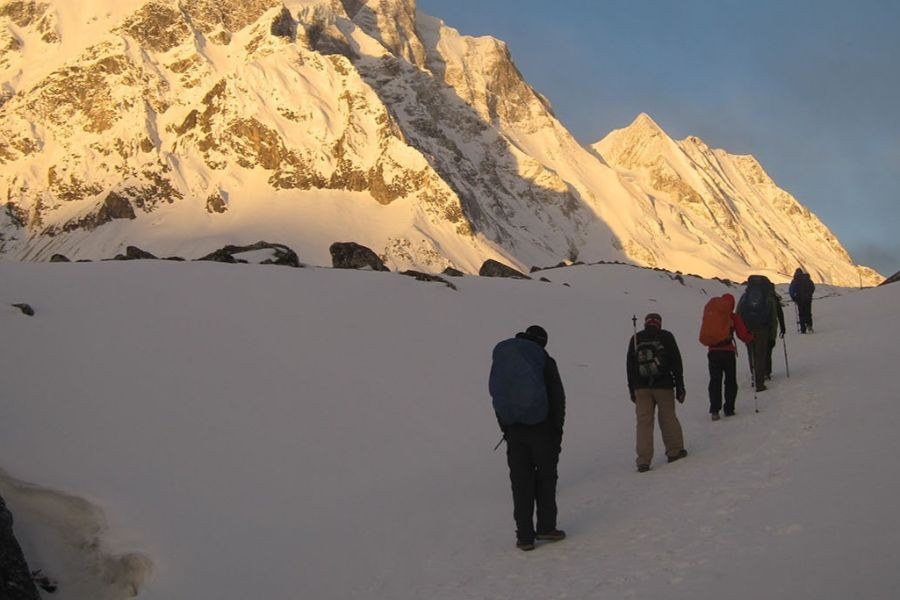
This challenging trek suits:
- Experienced Himalayan trekkers seeking remote adventures
- Mountaineers preparing for higher altitude expeditions
- Adventure photographers willing to endure hardships for unique landscapes
- Cultural enthusiasts interested in authentic Tibetan Buddhist communities
- Seasoned trekkers seeking less crowded alternatives to popular routes.
Not Recommended For
The Manaslu Circuit trek difficulty makes it unsuitable for:
- First-time high-altitude trekkers without proper experience
- Anyone with previous serious altitude sickness episodes
- Trekkers seeking comfortable accommodations and reliable facilities
- Those unable to commit to comprehensive pre-trek training programs
- Anyone with significant cardiovascular or respiratory health issues
Key Factors Affecting Manaslu Circuit Trek Difficulty
Altitude and Acclimatization Challenges
A solid acclimatization plan becomes important when faced with the challenges posed by altitude in a Manaslu trek. The normal itinerary has several acclimatization days built into it, but if serious altitude sickness does set in midway through the trek, the remote nature of the trek could lessen the likelihood of immediate evacuation options.
Typical acclimatization schedule:
- Days 1-3: Gradual ascent to Machha Khola (930m) and Jagat (1,340m)
- Days 4-6: Continued ascent through Deng (1,804m) to Namrung (2,540m)
- Days 7-9: Critical acclimatization in Samagaon (3,530m), with a rest day.
- Days 10-11: Final preparation in Samdo (3,860m) before pass attempt
- Day 12: Larkya La crossing and descent to Bhimthang (3,720 meters)
This schedule permits gradual adaptation, but responses of individuals vary immensely. Drink plenty of water, avoid alcohol, recognize early symptoms, and prepare to descend if necessary.
Weather and Seasonal Variation
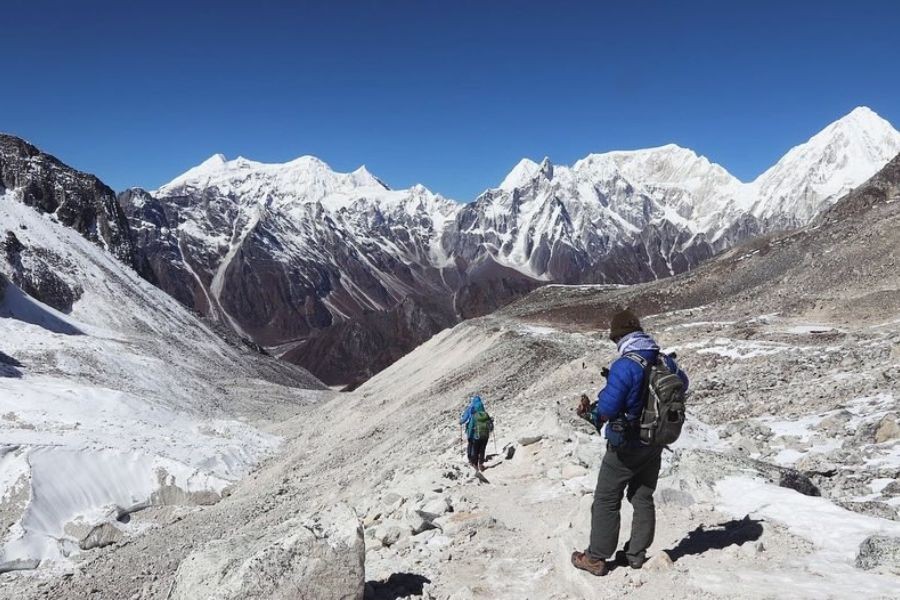
Weather conditions will have a sizable impact on the level of difficulty of the Manaslu Circuit trek throughout the year, since the peak seasons for the trek are narrow windows over the year.
Spring (March-May):
- Moderate temperatures, with the possibility of afternoon snow at altitude.
- Clear morning views with afternoon cloud buildup
- Rhododendron blooms at lower elevations
- Difficulty: Difficult
Summer/Monsoon (June-August):
- Heavy rainfall is creating dangerous river crossings
- Leeches at lower elevations and muddy trails
- Limited mountain visibility due to cloud cover
- Difficulty: Very Difficult (not recommended)
Autumn (September-November):
- Clear skies and excellent mountain visibility
- Stable weather patterns are ideal for pass crossing
- Cold nights but manageable daytime temperatures
- Difficulty: Difficult (optimal season)
Winter (December-February):
- Extreme cold with temperatures dropping below -20°C at altitude
- Heavy snowfall is making the pass crossing potentially dangerous
- Limited teahouse operations and increased logistical challenges
- Difficulty: Extremely Difficult
Duration and Daily Walking Requirements
The Manaslu Circuit trek challenges include sustaining energy for 14-18 consecutive days of demanding mountain walking. Daily schedules typically involve:
- 6-8 hours of walking across varied terrain
- Early morning starts (6-7 AM) for optimal weather windows
- Afternoon arrivals allowing rest before potential afternoon weather changes
- Continuous physical demand, with limited complete rest days.
Fitness Level Required for Manaslu Circuit Trek
Comprehensive Physical Preparation
The Manaslu trek fitness requirements demand months of dedicated training across multiple fitness components. Unlike moderate treks, Manaslu requires exceptional preparation to handle the sustained physical demands safely.
Cardiovascular Requirements:
- Ability to maintain a steady pace for 8+ hours at altitude.
- Strong heart and lung capacity for reduced oxygen environments
- Recovery ability for back-to-back challenging days
Strength Requirements:
- Superior leg strength for steep ascents and technical descents
- Core stability for traversing uneven terrain with a pack
- Upper body endurance for trekking pole use and pack carrying
Endurance Considerations:
- Mental stamina for multi-week expedition conditions
- Physical resilience for consecutive challenging days
- Recovery capacity in basic accommodation conditions
Recommended Training Program
Begin preparation at least 4-6 months before departure with this comprehensive Manaslu trek training plan:
Months 4-6 Before Trek:
- Establish base fitness with regular cardio (running, cycling, swimming)
- Begin weekend hiking with gradual distance increases
- Incorporate strength training focusing on legs and core
- Practice walking with a loaded pack
Months 2-3 Before Trek:
- Increase to full-day hikes carrying a 10-15kg pack
- Add stair climbing and hill running for specific muscle development
- Complete at least one multi-day trekking experience
- Begin altitude training if available (or altitude mask training).
Month 1 Before Trek:
- Peak fitness phase with the longest training hikes
- Equipment testing and pack weight optimization
- Mental preparation through challenging outdoor experiences
- Taper training in the final 2 weeks before departure
Related Blog: Manaslu Circuit trek Weather & Temperature by Months & Seasons
Essential Preparation for Manaslu Circuit Trek
Critical Gear Requirements
As the Manaslu Circuit trek difficulty can be managed with proper equipment, it is important to prepare appropriately for the remote location and conditions that may arise on the Manaslu trek. In planning your Manaslu Makalu trek packing list, you must take into account extreme weather, altitude, and duration.
Essential Clothing System:
- Moisture-wicking base layers (merino wool recommended)
- Insulating mid-layers (down or synthetic)
- Waterproof-breathable outer shell jacket and pants
- Insulated down jacket rated for -20°C conditions
- Warm hat, sun hat, and insulated gloves with liner gloves
- High-altitude sleeping bag rated to -15°C
Critical Equipment:
- Sturdy mountaineering boots with ankle support and crampon compatibility
- Adjustable trekking poles are essential for crossing Larkya La.
- Quality headlamp with extended battery life and spare batteries
- Large capacity backpack (65-75L) with rain cover
- Water purification system and insulated water bottles
- A comprehensive first aid kit with altitude sickness medications.
Technical Gear for Larkya La:
- Microspikes or lightweight crampons for icy conditions
- Glacier glasses with side protection
- High SPF sunscreen and lip protection
- Emergency shelter or bivy for potential weather delays
Mental and Logistical Preparation
Success on Manaslu requires comprehensive mental preparation beyond physical fitness. The Manaslu Circuit trek challenges test psychological resilience through:
- Extended periods in basic accommodation conditions
- Potential weather delays requiring flexibility
- Language barriers and cultural differences
- Emergency evacuation limitations in remote areas
Pre-departure preparation should include:
- Comprehensive travel insurance covering high-altitude trekking
- Emergency evacuation plans and communication devices
- Cultural research about Tibetan Buddhist traditions
- Basic Nepali language learning for improved local interactions
Food and Accommodation: What to Expect
Teahouse Facilities in Manaslu Region
Accommodations along the Manaslu Circuit differ greatly, ranging from lower valley villages to high altitude settlements. Knowing the limitations of these facilities will help in managing your expectations and lead to the successful completion of the Manaslu Circuit trek!
Lower Valley Teahouses (Days 1-6):
- Basic private rooms with shared bathroom facilities
- Communal dining areas with wood stoves
- Simple meals with limited menu options
- Minimal electricity and no heating in rooms
- Cold water washing facilities
Upper Valley and High-Altitude Lodges (Days 7-12):
- Very basic shared accommodation with thin walls
- Communal dining with central heating stove
- Limited menu focusing on high-energy foods
- No electricity or solar charging only
- Outhouse facilities and no shower access
- Extremely cold conditions requiring sleeping bags
Nutrition and Hydration Strategy
Maintaining energy and hydration becomes critical for managing the Manaslu trek altitude challenges. The limited food options require careful planning to meet nutritional needs during sustained physical exertion.
Typical meal options include:
- Dal Bhat (rice, lentils, vegetables) provides sustained energy
- Noodle soups and simple pasta dishes
- Tibetan bread and potatoes in various preparations
- Basic breakfast options like porridge and eggs
- Limited fresh vegetables and fruits at higher elevations
Hydration strategies:
- Consume 4-5 liters of fluid daily at altitude
- Warm drinks help maintain body temperature
- Water purification is essential throughout the trek
- Electrolyte replacement is important during physical exertion
Safety Considerations and Emergency Preparedness
Remote Location Challenges
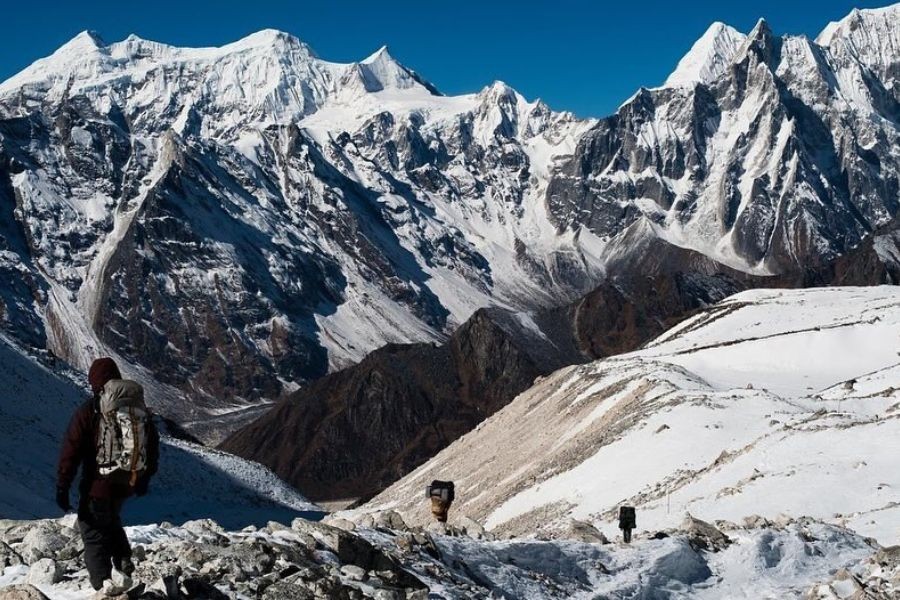
The Manaslu Circuit trek challenges include limited rescue access and communication capabilities in this restricted region. Emergencies require comprehensive preparation and understanding of evacuation limitations.
Emergency considerations:
- Helicopter rescue is only possible in good weather conditions
- Communication limited to satellite devices in upper regions
- Nearest medical facilities require multi-day evacuation
- Weather can delay rescue attempts for extended periods
Altitude Sickness Prevention and Management
Understanding altitude sickness symptoms and proper response protocols becomes essential for the Manaslu trek altitude environment. The high elevation and extended exposure increase risks beyond typical trekking scenarios.
Critical warning signs:
- Severe headaches not relieved by rest and medication
- Nausea, vomiting, and loss of appetite
- Difficulty sleeping and persistent fatigue
- Loss of coordination and confusion
- Fluid buildup in lungs (crackling breath sounds)
Emergency response protocols:
- Immediate descent if symptoms worsen
- Use of altitude medications (Diamox, Dexamethasone) only with proper medical guidance
- Continuous monitoring of affected individuals
- Evacuation preparation, including emergency communication
Can Beginners Attempt the Manaslu Circuit Trek?
Experience Requirements
The difficulty level of the Manaslu Circuit trek makes it unfavourable for trek beginners or for companions who have not had much previous exposure to high altitude challenges. Success on the route of Manaslu requires demonstrated capability in terms of being able to cope with the time spent in harsh mountain conditions.
Minimum experience requirements:
- Previous successful completion of challenging multi-day treks
- Experience sleeping at altitudes above 4,000 meters
- Demonstrated ability to handle difficult weather conditions
- Proven fitness for sustained physical exertion over multiple weeks
Alternative Preparation Routes
Trekkers aspiring to complete the Manaslu Circuit should build experience through progressively challenging adventures:
Preparation trek suggestions:
- Trekking to Everest Base Camp for duration and altitude
- Annapurna Circuit for a variety of weather and terrain conditions
- Island Peak or Mera Peak for technical high-altitude experience
- Multi-day wilderness backpacking for self-sufficiency skills
Manaslu Circuit Trek for Beginners: Honest Assessment
Adventure companies may advertise the Manaslu trek for novices as doable, given enough preparation; however, there is much support from experienced mountain professionals that this trek shouldn't be undertaken without considerable previous high-altitude trekking experience.
The mix of extreme altitude and technical terrain in a remote location, with limited infrastructure, is composed of variables that inexperienced trekkers may not be able to prepare for solely through physical fitness training. The Larkya La pass difficulty alone requires mountain skills and altitude acclimatization experience that goes hand-in-hand with previous high altitude adventures.
Related blog: Best Time for Manaslu Circuit Trek: Your Complete Guide to Nepal's Hidden Gem
Frequently Asked Questions About Manaslu Circuit Trek Difficulty
What makes the Manaslu Circuit Trek so difficult?
Manaslu Circuit trek difficulty results from a number of factors: extreme altitude with minimal acclimatization time, technical terrain including approaches to glaciers, remoteness and access to rescue, basic or non-existent support facilities, unpredictable weather, and the challenge of crossing the Larkya La Pass at 5,106 meters.
How difficult is it to climb Manaslu compared to Everest Base Camp?
Although Everest Base Camp is at a higher altitude (5,364m vs 5,106m), the diverse difficulty for the Manaslu Circuit trek often exceeds EBC due to the technical terrain, limited infrastructure, remoteness, length of the trek, and the strenuous conditions of crossing the pass, which may necessitate glacier navigation.
What are the main risks of the Manaslu Circuit Trek?
The main risks include: severe altitude sickness without a practical evacuation plan, hypothermia and frostbite in extreme weather, injuries from technical terrain and river crossings, getting lost in unmarked high-altitude sections, and weather delays that limit food and shelter.
Can you do the Manaslu Circuit without a guide?
Although possible for very experienced mountaineers, with the trekking and difficulty involved in the Manaslu trek and also the permit process, it is strongly encouraged to do your trek with a guide. Manaslu is a restricted area, and a special permit is required; local knowledge is invaluable for navigation (including safety); guides provide liaison support for emergencies.
When is the best time for the Manaslu Circuit Trek?
The Manaslu Circuit is best during pre-monsoon (March-May) and post-monsoon (September-November) seasons, with October and November providing the best conditions. Difficulty can increase greatly during the monsoon season (June-August), due to very difficult river crossings. During winter (December-February), situations can be hazardous due to extremely cold temperatures and snow.
What fitness level do you need for the Manaslu Circuit?
Manaslu trek fitness requirements would be: excellent cardiovascular fitness, the ability to walk for more than 8 hours a day at altitude for multiple weeks, high altitude experience above 4000 meters, and strong mental resilience to be able to deal with poor weather and possible emergencies.
How long does the Manaslu Circuit Trek take?
Manaslu circuit treks are typically 14-18 days, depending on how comfortable you are with your acclimatization schedule and if weather delays are encountered. Manaslu circuit trek challenges often require buffer days for bad weather and acclimatization, so it is always helpful to have flexible scheduling to be successful.
What equipment do I need for the Manaslu Circuit?
The most critical equipment is pairs of crampon-compatible mountaineering boots, a -15°C sleeping bag, down jackets rated for extreme cold, waterproof shells and insulated inner layers, trekking poles and crampons or microspikes, a fully stocked first aid kit, and an emergency communication device. Manaslu trek packing list must also account for extreme weather and extended duration.
Conclusion
The Manaslu Circuit Trek is a challenging and meaningful high-elevation trek in Nepal that will require considerable preparation, experience, and respect for the mountain environment. Manaslu Circuit trek difficulty entails much more than just stamina or physical fitness; it is about technical skills, altitude acclimatization, mental fortitude, and preparation for any potential emergencies.
Manaslu is a reward for all types of trekkers who are already comfortable around high altitude terrain and are looking for an authentic wilderness experience away from the high foot traffic that popular routes can attract. The pristine landscape, rich Tibetan Buddhist culture, and stunning mountain vistas should provide memorable experiences for trekkers prepared for the trek.
However, the difficulty levels of the Manaslu trek mean an honest assessment of one's capabilities should occur before committing to this potential arduous expedition. Prior experience at high altitudes, ability to show fit capabilities in addition to good planning, will become the baseline minimum requirements to safely and successfully finish the trek.
The Larkya La pass's difficulty and extended exposure to altitude create risks that pose a legitimate need for other experiences and the ability to effectively instruct decision-making while preparing for emergencies. Lastly, it should also be noted that while some adventure travel companies might try to sell this trek to aspiring beginners, it is important to understand the reality of conditions and risk factors that exist to treat the Manaslu Circuit as an advanced mountaineering objective, with all of the required preparation and expectations, experience included.
If you're up for the challenge, the Manaslu Circuit is a genuine Himalayan adventure that pushes your limits to discover Nepal's beauty and cultural the exotic places it only allows small numbers of trekkers who seek something special and untamed (for now). Whether you are successful or not depends not just on your physical fitness, but whether you have the mental toughness, cultural sensitivity, and respect for your mountain environment that generations of adventurers have learned while exploring the extreme.
Ready to take on the ultimate Himalayan challenge?
Make sure you have the necessary experience, preparation, and support team for this demanding journey. Work with experienced operators who understand the difficulties of the Manaslu Circuit trek and who can provide crucial advice to help you facilitate a safe & successful conclusion to what will be another epic adventure.
Inquire Now: [email protected]
Expert Consultation: WhatsApp: +977 9851006023 (Bikesh)
.jpg)




